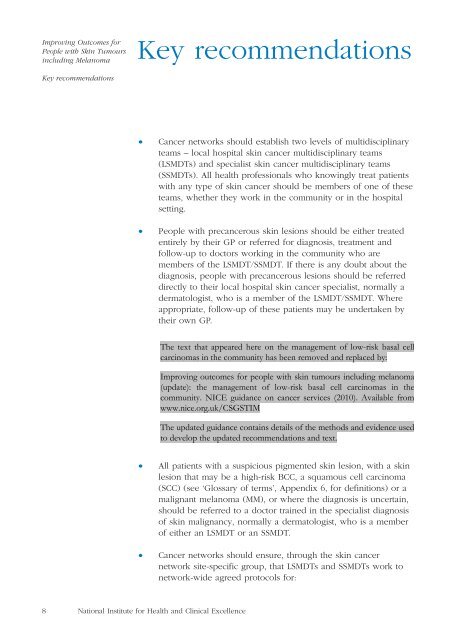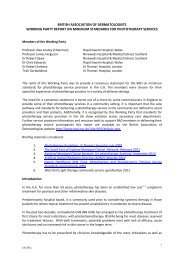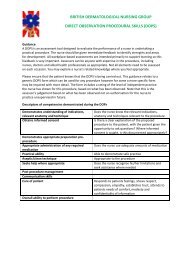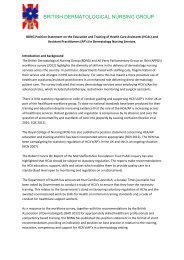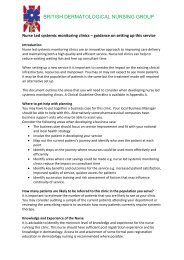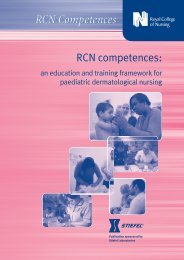Improving outcomes for people with skin tumours including melanoma
Improving outcomes for people with skin tumours including melanoma
Improving outcomes for people with skin tumours including melanoma
Create successful ePaper yourself
Turn your PDF publications into a flip-book with our unique Google optimized e-Paper software.
<strong>Improving</strong> Outcomes <strong>for</strong><br />
People <strong>with</strong> Skin Tumours<br />
<strong>including</strong> Melanoma<br />
Key recommendations<br />
Key recommendations<br />
• Cancer networks should establish two levels of multidisciplinary<br />
teams – local hospital <strong>skin</strong> cancer multidisciplinary teams<br />
(LSMDTs) and specialist <strong>skin</strong> cancer multidisciplinary teams<br />
(SSMDTs). All health professionals who knowingly treat patients<br />
<strong>with</strong> any type of <strong>skin</strong> cancer should be members of one of these<br />
teams, whether they work in the community or in the hospital<br />
setting.<br />
• People <strong>with</strong> precancerous <strong>skin</strong> lesions should be either treated<br />
entirely by their GP or referred <strong>for</strong> diagnosis, treatment and<br />
follow-up to doctors working in the community who are<br />
members of the LSMDT/SSMDT. If there is any doubt about the<br />
diagnosis, <strong>people</strong> <strong>with</strong> precancerous lesions should be referred<br />
directly to their local hospital <strong>skin</strong> cancer specialist, normally a<br />
dermatologist, who is a member of the LSMDT/SSMDT. Where<br />
appropriate, follow-up of these patients may be undertaken by<br />
their own GP.<br />
• Patients <strong>with</strong> low-risk basal cell carcinomas (BCCs) (see<br />
‘Glossary of terms’, Appendix 6, <strong>for</strong> definitions) should be<br />
diagnosed, treated and followed up by doctors working in the<br />
community as part of the LSMDT/SSMDT (usually a GP <strong>with</strong> a<br />
special interest in dermatology [GPwSI]), or a local hospital <strong>skin</strong><br />
cancer specialist, normally a dermatologist, who is a member of<br />
the LSMDT/SSMDT and to whom they have been directly<br />
referred. Where there is doubt about the lesion being low or<br />
high grade, the patient should be referred directly to the<br />
LSMDT/SSMDT.<br />
• All patients <strong>with</strong> a suspicious pigmented <strong>skin</strong> lesion, <strong>with</strong> a <strong>skin</strong><br />
lesion that may be a high-risk BCC, a squamous cell carcinoma<br />
(SCC) (see ‘Glossary of terms’, Appendix 6, <strong>for</strong> definitions) or a<br />
malignant <strong>melanoma</strong> (MM), or where the diagnosis is uncertain,<br />
should be referred to a doctor trained in the specialist diagnosis<br />
of <strong>skin</strong> malignancy, normally a dermatologist, who is a member<br />
of either an LSMDT or an SSMDT.<br />
• Cancer networks should ensure, through the <strong>skin</strong> cancer<br />
network site-specific group, that LSMDTs and SSMDTs work to<br />
network-wide agreed protocols <strong>for</strong>:<br />
8 National Institute <strong>for</strong> Health and Clinical Excellence


